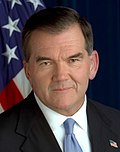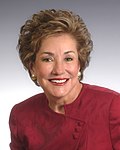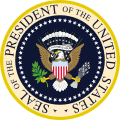Selection process
Bush had initially chosen Dick Cheney to lead the search for his vice presidential running mate. In 1992, Bush had supported Cheney as a replacement for Dan Quayle on his father's ultimately unsuccessful national ticket. [2] After more than three months of extensive research, Cheney recommended John Danforth to be the nominee, [3] as the other choices' strengths were offset by liberal stances. [4] Bush heavily considered Danforth. However, Danforth, who wanted to continue living mainly in Missouri, formally declined to run as vice president on July 11, 2000; [5] nevertheless Danforth would eventually be appointed to the Bush Administration as a special envoy to Sudan on September 6, 2001. [6] Bush ultimately asked Cheney himself to be the nominee. It was acknowledged in a July 28, 2000 New York Times article that the decision to select Cheney as Bush's Vice Presidential nominee was in fact secretly made "weeks" before it was formally announced on July 25, 2000. [7]
According to the Twelfth Amendment to the United States Constitution, the presidential electors from Texas (in the United States Electoral College) could not vote for candidates for president and vice president who were both from Texas. On July 21, 2000, Cheney changed his voter registration from Texas to Teton County, Wyoming, which, combined with other actions, ultimately allowed the Texas electors to vote for both Bush and Cheney. [8] [9] [10]
By picking Cheney, Bush had a running mate who had years of experience as well as an extensive foreign policy expertise. After Cheney, who was serving as CEO of Halliburton, reported his findings back to Bush, Bush surprised pundits by asking Cheney himself to be his running mate. Bush told supporters that regional considerations would have less bearing on his decision than the candidate's ability to take over the office of the presidency. At the selection announcement, Bush said that Cheney, who had worked under all five presidential administrations between 1969 and 1993, was qualified, respected and shared his vision for America. [11]
There was a short-lived movement to draft Elizabeth Dole, but that effort did not move forward. [12]
This page is based on this
Wikipedia article Text is available under the
CC BY-SA 4.0 license; additional terms may apply.
Images, videos and audio are available under their respective licenses.






















